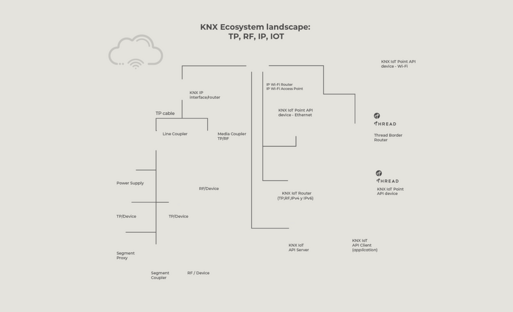
KNX IoT-Geräte und -Lösungen bringen intelligente Häuser un Gebäude auf die nächste Stufe.
Warum KNX IoT?
- Interoperabel und sicher: KNX ist die Referenz, wenn es um Interoperabilität geht. Nehmen Sie einfach zwei beliebige zertifizierte Geräte von einem beliebigen Hersteller, und sie werden einfach auf der Anwendungsebene auf sichere Weise zusammenarbeiten. Dieser Philosophie folgend, wurde KNX IoT entwickelt, um das höchste Sicherheitsniveau zu gewährleisten. KNX IoT-Geräte sind von Haus aus mit Sicherheit ausgestattet. Mit dieser robusten neuen KNX IoT Technologie können Hersteller und Entwickler die besten Geräte, Lösungen und Dienste entwickeln, die von den Fachleuten in der Branche der intelligenten Häuser und Gebäude installiert werden.
- Native KNX IoT Geräte (IPv6): KNX Geräte verwenden jetzt einen neuen Ansatz, um in die IPv6 Architektur zu passen. Die neue Generation von KNX IoT Geräten wird in der Lage sein, sich mit IP Netzwerken (verkabelt und/oder drahtlos) zu verbinden, um mit anderen KNX IoT Geräten sowie mit klassischen KNX Geräten, die Twister Pair oder Funkfrequenz verwenden, zu kommunizieren.
- Standardisierte API: Für die Geräte, die in ein KNX Netzwerk integriert werden müssen, ist dies nun dank einer standardisierten API möglich, die sich mit KNX Installationen verbinden kann. Diese API ist einfach, sicher, abstrahiert vom KNX-spezifischen Wissen und zukunftssicher.
- Ein Werkzeug: ETS: All diese Möglichkeiten werden durch den Einsatz der ETS ermöglicht. Mit der ETS können KNX Geräte von über 500 Herstellern unabhängig von ihrer physikalischen Schicht konfiguriert werden, und Projektinformationen können mit einem herstellerunabhängigen Tool an jeden KNX IoT API Server exportiert werden. Die ETS bietet grundlegende Interoperabilität in einem attraktiven Tool mit einer modernen Benutzeroberfläche.
- KNX, das größte Ökosystem in der Haus- und Gebäudeautomation: Mit dieser neuen Möglichkeit, über die KNX Technologie zu kommunizieren, wird die Flexibilität erhöht. Hersteller können nun neue Entwicklungsmöglichkeiten nutzen, um innovative Produkte und Lösungen zu schaffen; und auch Fachleute haben mehr Möglichkeiten, ein größeres KNX Ökosystem in ihren Projekten zu schaffen.
Machen Sie jedes Haus und Gebäude mit KNX IoT intelligent
Erfahren Sie in diesem kurzen Einführungsvideo, warum KNX IoT eine Welt der Möglichkeiten für intelligente Häuser und Gebäude eröffnet.
Ausführlichere Videos und Webinare zu KNX IoT finden Sie auf unserem YouTube-Kanal.
KNX, die größte Entwicklungslandschaft ihrer Art
Eine bahnbrechende Entwicklungsplattform, die als Grundlage für bemerkenswerte Lösungen dient, wurde der Welt im Jahr 2023 vorgestellt und ermöglicht alle Geschäftsfälle in den Bereichen Smart Home und Gebäude. Von einzelnen Produkten bis hin zu Dienstleistungen kann jeder Hersteller oder Entwickler die notwendigen Ressourcen finden, um einzigartige Lösungen zu schaffen.
Entdecken Sie, wie das KNX Ökosystem funktioniert, indem Sie mit dem Mauszeiger über die verschiedenen Elemente in der Abbildung unten fahren.
KNX IoT Entwicklung und KNX Startup Inkubator
Interessiert an KNX IoT Entwicklung? Erfahren Sie mehr über KNX IoT und wie Sie für KNX IoT entwickeln können, die Vorteile und die Unterstützung, die KNX über unseren KNX Startup Inkubator bietet.
Begleiten Sie uns auf unserer Reise
Erstellen Sie ein MyKNX Konto und bleiben Sie auf dem Laufenden über das Neueste in Sachen KNX IoT, Technologieveranstaltungen, innovative KNX Produkte und mehr. Treten Sie unserer Gemeinschaft bei, um exklusive Einblicke zu erhalten und Teil der Zukunft der nachhaltigen Energie zu sein. Melden Sie sich noch heute an und bleiben Sie in Verbindung!




















